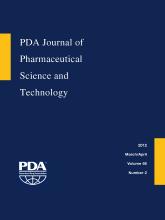Abstract
The interior barrel of the prefilled syringe is often lubricated/siliconized by the syringe supplier or at the syringe filling site. Syringe siliconization is a complex process demanding automation with a high degree of precision; this information is often deemed “know-how” and is rarely published. The purpose of this study is to give a detailed account of developing and optimizing a bench-top siliconization unit with nozzle diving capabilities. This unit comprises a liquid dispense pump unit and a nozzle integrated with a Robo-cylinder linear actuator. The amount of coated silicone was determined by weighing the syringe before and after siliconization, and silicone distribution was visually inspected by glass powder coating or characterized by glide force testing. Nozzle spray range, nozzle retraction speed, silicone-coated amount, and air-to-nozzle pressure were found to be the key parameters affecting silicone distribution uniformity. Distribution uniformity is particularly sensitive to low-target silicone amount where the lack of silicone coating on the barrel near the needle side often caused the syringes to fail the glide force test or stall when using an autoinjector. In this bench-top unit we identified optimum coating conditions for a low silicone dose, which were also applicable to a pilot-scale siliconization system. The pilot unit outperformed the bench-top unit in a tighter control (standard deviation) in coated silicone amount due to the elimination of tubing flex. Tubing flex caused random nozzle mis-sprays and was prominent in the bench-top unit, while the inherent design of the pilot system substantially limited tubing flux. In summary, this bench-top coating unit demonstrated successful siliconization of the 1 mL long syringe with ∼0.2 mg of silicone oil using a spraying cycle also applicable to larger-scale siliconization.
LAY ABSTRACT: Syringe siliconization can be considered a well-established manufacturing process and has been implemented by numerous syringe providers. However, its technical details and associated critical process parameters are rarely published. The purpose of this study is three-fold: (1) to reveal design details of a bench-top siliconization unit, (2) to identify critical process parameters and determine their optimum range to provide consistent and even silicone coating, and (3) to demonstrate the applicability of the optimum process condition derived from the bench-top unit to a pilot siliconization unit. The outcomes of this study will benefit scientists and engineers developing pre-filled syringe products by helping them to better understanding silicone spray coating principles and their relationship to siliconization processes in a large-scale manufacturing setting.
- Prefilled syringe
- Siliconization
- Dive-in nozzle spray
- Silicone amount
- Silicone distribution
- Glide force
- Glass powder testing
- © PDA, Inc. 2012
PDA members receive access to all articles published in the current year and previous volume year. Institutional subscribers received access to all content. Log in below to receive access to this article if you are either of these.
If you are neither or you are a PDA member trying to access an article outside of your membership license, then you must purchase access to this article (below). If you do not have a username or password for JPST, you will be required to create an account prior to purchasing.
Full issue PDFs are for PDA members only.
Note to pda.org users
The PDA and PDA bookstore websites (www.pda.org and www.pda.org/bookstore) are separate websites from the PDA JPST website. When you first join PDA, your initial UserID and Password are sent to HighWirePress to create your PDA JPST account. Subsequent UserrID and Password changes required at the PDA websites will not pass on to PDA JPST and vice versa. If you forget your PDA JPST UserID and/or Password, you can request help to retrieve UserID and reset Password below.






